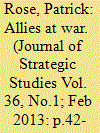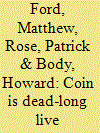| Srl | Item |
| 1 |
ID:
120285


|
|
|
|
|
| Publication |
2013.
|
| Summary/Abstract |
This article compares the philosophy and practice of command in the British and US Armies during the Italian Campaign of 1943-44. It assesses pre-war influences on the command approach adopted by each army, and shows how refinements derived from wartime experience enabled British and American commanders to successfully utilise mission command principles to outfight the German Army in the latter years of World War II. This examination directly challenges the historical consensus that Allied commanders were disadvantaged by an inability to exploit the advantages of mission command, and that the German Army retained superior command practices, despite its other failings, throughout the fighting between 1939 and 1945. These conclusions hold additional relevance to modern military organisations which have emphasised mission command as the optimal solution to effective command in battle since the 1980s, but from an inaccurate understanding of German, British and American command traditions and experience that persists to this day.
|
|
|
|
|
|
|
|
|
|
|
|
|
|
|
|
| 2 |
ID:
122393


|
|
|
|
|
| Publication |
2012.
|
| Summary/Abstract |
Donald Rumsfeld was right. Force transformation works. The techniques
that led to the initial victories in Afghanistan in 2001 were precisely those
that produced success in Libya in 2011.1
Small-scale deployments of special
forces backed by precision strike and deep attack capabilities used to support an
allied indigenous armed group proved an effective military tool for achieving
specific strategic outcomes. In contrast, the results of large-scale troop deployments as part of counterinsurgency (COIN), stabilization and nation-building
activities over the past 1ten0 years in Iraq and Afghanistan have been less definitive. Despite intensive investment in blood, treasure, and military effort, the
precise long-term outcomes of these two campaigns remain unclear and will
be open to debate for years to come. This challenging operational experience
has, however, highlighted some necessary and enduring truths about the use of
military force. Despite great advances in military technology and the increasing
sophistication with which organized violence can be applied in a range of situations, all warfare remains characterized by uncertainty; there exists no silver
bullet that can guarantee enduring political success from the barrel of a gun.2
|
|
|
|
|
|
|
|
|
|
|
|
|
|
|
|